Vegetation Determines Lake Sediment Carbon Accumulation during Holocene in the Forest–Steppe Ecotone in Northern China
Abstract
1. Introduction
2. Study Areas and Methods
2.1. Study Site
2.2. Methods
2.2.1. Sampling
2.2.2. Chronological Model and Sediment Accumulation Rate (SAR)
2.2.3. Carbon Accumulation Rate (CAR)
2.2.4. Proxies of Climate, Vegetation and Soil Changes
2.2.5. Data Analysis
3. Results
3.1. Temporal Variations of the SAR and CAR
3.2. Contributions of the Abiotic and Biotic Factors to CAR Dynamics
4. Discussion
5. Conclusions
Supplementary Materials
Author Contributions
Funding
Conflicts of Interest
References
- IPCC. Climate Change 2014: Impacts, Adaptation, and Vulnerability. Part A: Global and Sectoral Aspects. Contribution of Working Group II to the Fifth Assessment Report of the Intergovernmental Panel on Climate Change; Cambridge University Press: Cambridge, UK; New York, NY, USA, 2014. [Google Scholar]
- Charman, D.J.; Amesbury, M.J.; Hinchliffe, W.; Hughes, P.D.M.; Mallon, G.; Blake, W.H.; Daley, T.J.; Gallego-Sala, A.V.; Mauquoy, D. Drivers of Holocene peatland carbon accumulation across a climate gradient in northeastern North America. Quat. Sci. Rev. 2015, 121, 110–119. [Google Scholar] [CrossRef]
- Heathcote, A.J.; Anderson, N.J.; Prairie, Y.T.; Engstrom, D.R.; del Giorgio, P.A. Large increases in carbon burial in northern lakes during the Anthropocene. Nat. Commun. 2015, 6, 10016. [Google Scholar] [CrossRef]
- Mackay, A.W.; Seddon, A.W.; Leng, M.J.; Heumann, G.; Morley, D.W.; Piotrowska, N.; Rioual, P.; Roberts, S.; Swann, G.E.A. Holocene carbon dynamics at the forest-steppe ecotone of southern Siberia. Glob. Chang. Biol. 2017, 23, 1942–1960. [Google Scholar] [CrossRef] [PubMed]
- Kastowski, M.; Hinderer, M.; Vecsei, A. Long-term carbon burial in European lakes: Analysis and estimate. Glob. Biogeochem. Cycles 2011, 25, GB3019. [Google Scholar] [CrossRef]
- Anderson, N.J.; D’Andrea, W.; Fritz, S.C. Holocene carbon burial by lakes in SW Greenland. Glob. Chang. Biol. 2009, 15, 2590–2598. [Google Scholar] [CrossRef]
- Anderson, N.J.; Bennion, H.; Lotter, A.F. Lake eutrophication and its implications for organic carbon sequestration in Europe. Glob. Chang. Biol. 2014, 20, 2741–2751. [Google Scholar] [CrossRef] [PubMed]
- Dean, W.E.; Gorham, E. Magnitude and significance of carbon burial in lakes, reservoirs and peatlands. Geology 1998, 26, 535–538. [Google Scholar] [CrossRef]
- Dong, X.; Anderson, N.J.; Yang, X.; Xu, C.; Ji, S. Carbon burial by shallow lakes on the Yangtze floodplain and its relevance to regional carbon sequestration. Glob. Chang. Biol. 2012, 18, 2205–2217. [Google Scholar] [CrossRef]
- Duan, X.N.; Wang, X.K.; Lu, F. Carbon sequestration and its potential by wetland ecosystems in China. Acta Ecol. Sin. 2008, 28, 463–469, (In Chinese with English Abstract). [Google Scholar]
- Xu, L.M.; Li, Y.; Ye, W.T.; Zhang, X.Z.; Li, Y.C.; Zhang, Y.X. Holocene lake carbon sequestration, hydrological status and vegetation change, China. Sci. Cold Arid Reg. 2019, 11, 295–326. [Google Scholar]
- Zhang, F.J.; Xue, B.; Yao, S.C. The organic carbon burial rate in Chinese lake sediments during Holocene megathermal. Quat. Sci. 2013, 33, 401–402, (In Chinese with English Abstract). [Google Scholar]
- Wang, M.; Chen, H.; Yu, Z.; Wu, J.; Zhu, Q.; Peng, C.; Wang, Y.; Qin, B. Carbon accumulation and sequestration of lakes in China during the Holocene. Glob. Chang. Biol. 2015, 21, 4436–4448. [Google Scholar] [CrossRef]
- Peng, Y.; Xiao, J.; Nakamura, T.; Liu, B.; Inouchi, Y. Holocene East Asian monsoonal precipitation pattern revealed by grain-size distribution of core sediments of Daihai Lake in Inner Mongolia of north-central China. Earth Planet. Sci. Lett. 2005, 233, 467–479. [Google Scholar] [CrossRef]
- Zhao, M.; Heinsch, F.A.; Nemani, R.R.; Running, S.W. Improvements of the MODIS terrestrial gross and net primary production global data set. Remote Sens. Environ. 2005, 95, 164–176. [Google Scholar] [CrossRef]
- Jiang, Q.F.; Ji, J.F.; Shen, J.; Matsumoto, R.; Tong, G.B.; Qian, P.; Ren, X.M.; Yan, D.Z. Holocene vegetational and climatic variation in westerly-dominated areas of Central Asia inferred from the Sayram Lake in northern Xinjiang, China. Sci. China Earth Sci. 2013, 56, 339–353. [Google Scholar] [CrossRef]
- Xie, Z.; He, J.; Lü, C.; Zhang, R.; Zhou, B.; Mao, H.; Song, W.; Zhao, W.; Hou, D.; Wang, J. Organic carbon fractions and estimation of organic carbon storage in the lake sediments in Inner Mongolia Plateau, China. Environ. Earth Sci. 2014, 73, 2169–2178. [Google Scholar] [CrossRef]
- Liu, H.; Cui, H.; Huang, Y. Detecting Holocene movements of the woodland-steppe ecotone in northern China using discriminant analysis. J. Quat. Sci. 2001, 16, 237–244. [Google Scholar] [CrossRef]
- Liu, H.; Yin, Y.; Zhu, J.; Zhao, F.; Wang, H. How did the forest respond to Holocene climate drying at the forest–steppe ecotone in northern China? Quat. Int. 2010, 227, 46–52. [Google Scholar] [CrossRef]
- Hao, Q.; Liu, H.; Yin, Y.; Wang, H.; Feng, M. Varied responses of forest at its distribution margin to Holocene monsoon development in northern China. Palaeogeogr. Palaeocl. 2014, 409, 239–248. [Google Scholar] [CrossRef]
- Xiao, J.; Xu, Q.; Nakamura, T.; Yang, X.; Liang, W.; Inouchi, Y. Holocene vegetation variation in the Daihai Lake region of north-central China: A direct indication of the Asian monsoon climatic history. Quat. Sci. Rev. 2004, 23, 1669–1679. [Google Scholar] [CrossRef]
- Jiang, W.; Guo, Z.; Sun, X.; Wu, H.; Chu, G.; Yuan, B.; Hatté, C.; Guiot, J. Reconstruction of climate and vegetation changes of Lake Bayanchagan (Inner Mongolia): Holocene variability of the East Asian monsoon. Quat. Res. 2006, 65, 411–420. [Google Scholar] [CrossRef]
- Zhao, Y.; Yu, Z.; Chen, F. Spatial and temporal patterns of Holocene vegetation and climate changes in arid and semi-arid China. Quat. Int. 2009, 194, 6–18. [Google Scholar] [CrossRef]
- Marcott, S.A.; Mix, A.C. A reconstruction of regional and global temperature for the past 11,300 years. Science 2013, 339, 1198. [Google Scholar] [CrossRef]
- Feng, M.; Wang, Q.; Hao, Q.; Yin, Y.; Song, Z.; Wang, H.; Liu, H. Determinants of soil erosion during the last 1600 years in the forest–steppe ecotone in Northern China reconstructed from lacustrine sediments. Palaeogeogr. Palaeocl. 2016, 449, 79–84. [Google Scholar] [CrossRef]
- Yu, K.; Xu, H.; Lan, J.; Sheng, E.; Liu, B. Climate change and soil erosion in a small alpine lake basin on the Loess Plateau, China. Earth Surf. Process. Landforms 2017, 42, 1238–1247. [Google Scholar] [CrossRef]
- Zhang, J.; Jia, Y.; Lai, Z.; Long, H.; Yang, L. Holocene evolution of Huangqihai Lake in semi-arid northern China based on sedimentology and luminescence dating. Holocene 2011, 21, 1261–1268. [Google Scholar] [CrossRef]
- Zhang, Y.; Liu, H. How did climate drying reduce ecosystem carbon storage in the forest–steppe ecotone? A case study in Inner Mongolia, China. J. Plant Res. 2010, 123, 543–549. [Google Scholar] [CrossRef]
- Li, H.; Liu, Q.S.; Wang, J.X. Study of evolution of Huangqihai and Daihai Lakes in Holocene in Inner Mongolia Plateau. J. Lake Sci. 1992, 4, 31–39, (In Chinese with English Abstract). [Google Scholar]
- Chen, M.M.; Liu, J.G. Landscape dynamics in the Huangqihai Lake basin from 1976 to 2010. J. Northwest For. Univ. 2014, 29, 165–170, (In Chinese with English Abstract). [Google Scholar]
- Blaauw, M.; Christen, J.A. Flexible paleoclimate age-depth models using an autoregressive gamma process. Bayesian Anal. 2011, 3, 457–474. [Google Scholar] [CrossRef]
- Blaauw, M.; Christen, J.A.; Bennett, K.D.; Reimer, P.J. Double the dates and go for Bayes—Impacts of model choice, dating density and quality on chronologies. Quat. Sci. Rev. 2018, 188, 58–66. [Google Scholar] [CrossRef]
- Avnimelech, Y.; Ritvo, G.; Meijer, L.E.; Kochba, M. Water content, organic carbon and dry bulk density in flooded sediments. Aquacult. Eng. 2001, 25, 25–33. [Google Scholar] [CrossRef]
- Egger, M.; Hagens, M.; Sapart, C.J.; Dijkstra, N.; Slomp, C.P. Iron oxide reduction in methane-rich deep Baltic Sea sediments. Geochim. Cosmochim. Acta 2017, 207, 256–276. [Google Scholar] [CrossRef]
- Campbell, I.D.; Campbell, C.; Vitt, D.H.; Kelker, D.; Laird, L.D.; Trew, D.; Kotak, B.; Leclair, D.; Bayley, S. A first estimate of organic carbon storage in Holocene lake sediments in Alberta, Canada. J. Paleolimnol. 2000, 24, 395–400. [Google Scholar] [CrossRef]
- Turcq, B.; Albuquerque, A.L.S.; Cordeiro, R.C.; Sifeddine, A.; Capitâneo, J. Accumulation of organic carbon in five Brazilian lakes during the Holocene. Sediment Geol. 2002, 148, 319–342. [Google Scholar] [CrossRef]
- Wang, Y.J.; Cheng, H.; Edwards, R.L.; An, Z.S.; Wu, J.Y.; Shen, C.C.; Dorale, J.A. A High-Resolution Absolute-Dated Late Pleistocene Monsoon Record from Hulu Cave, China. Science 2001, 294, 2345–2348. [Google Scholar] [CrossRef]
- Dykoski, C.; Edwards, R.; Cheng, H.; Yuan, D.; Cai, Y.; Zhang, M.; Lin, Y.; Qing, J.; An, Z.; Revenaugh, J. A high-resolution, absolute-dated Holocene and deglacial Asian monsoon record from Dongge Cave, China. Earth Planet. Sci. Lett. 2005, 233, 71–86. [Google Scholar] [CrossRef]
- Wang, Y.; Cheng, H.; Edwards, R.L.; Kong, X.; Shao, X.; Chen, S.; Wu, J.; Jiang, X.; Wang, X.; An, Z. Millennial- and orbital-scale changes in the East Asian monsoon over the past 224,000 years. Nature 2008, 451, 1090. [Google Scholar] [CrossRef]
- Liu, J.; Chen, J.; Zhang, X.; Li, Y.; Rao, Z.; Chen, F. Holocene East Asian summer monsoon records in northern China and their inconsistency with Chinese stalagmite δ18O records. Earth Sci. Rev. 2015, 148, 194–208. [Google Scholar] [CrossRef]
- Fang, X.Q.; Hou, G.L. Synthetically reconstructed Holocene temperature change in China. Sci. Geogr. Sin. 2011, 31, 385–393, (In Chinese with English Abstract). [Google Scholar]
- Li, J.; Dodson, J.; Yan, H.; Zhang, D.D.; Zhang, X.J.; Xu, Q.H.; Lee, H.F.; Pei, Q.; Cheng, B.; Li, C.H.; et al. Quantifying climatic variability in monsoonal northern China over the last 2200 years and its role in driving Chinese dynastic changes. Quat. Sci. Rev. 2017, 159, 35–46. [Google Scholar] [CrossRef]
- Herzschuh, U. Reliability of pollen ratios for environmental reconstructions on the Tibetan Plateau. J. Biogeogr. 2010, 34, 1265–1273. [Google Scholar] [CrossRef]
- Zhao, Y.; Yu, Z. Vegetation response to Holocene climate change in East Asian monsoon-margin region. Earth Sci. Rev. 2012, 113, 1–10. [Google Scholar] [CrossRef]
- Wu, Y.; Lücke, A.; Jin, Z.; Wang, S.; Schleser, G.H.; Battarbee, R.W.; Xia, W. Holocene climate development on the central Tibetan Plateau: A sedimentary record from Cuoe Lake. Palaeogeogr. Palaeocl. 2006, 234, 328–340. [Google Scholar]
- Zhang, C.; Wang, H.; Liu, H.; Cheng, Y.; Song, Y.; Luo, Y.; Deng, L. Climatic and environmental changes occurring during the last 5520 years on Alpine Belt of Taibai Mountain: The records of a few proxies of sediments from Foye Chi and their interpretations. Acta Sci. Nat. Univ. Pekin. 2015, 51, 1091–1101, (In Chinese with English Abstract). [Google Scholar]
- Wang, H.; Liu, H.; Zhu, J.; Yin, Y. Holocene environmental changes as recorded by mineral magnetism of sediments from Anguli-nuur Lake, southeastern Inner Mongolia Plateau, China. Palaeogeogr. Palaeocl. 2010, 285, 30–49. [Google Scholar] [CrossRef]
- Wang, H.; Liu, H.; Zhao, F.; Yin, Y.; Zhu, J.L.; Snowball, I. Early-and mid-Holocene palaeoenvironments as revealed by mineral magnetic, geochemical and palynological data of sediments from Bai Nuur and Ulan Nuur, southeastern inner Mongolia Plateau, China. Quat. Int. 2012, 250, 100–118. [Google Scholar] [CrossRef]
- Yang, S.; Ding, F.; Ding, Z. Pleistocene chemical weathering history of Asian arid and semi-arid regions recorded in loess deposits of China and Tajikistan. Geochim. Cosmochim. Acta 2006, 70, 1695–1709. [Google Scholar] [CrossRef]
- Sun, Q.; Wang, S.; Zhou, J.; Chen, Z.; Shen, J.; Xie, X.; Wu, F.; Chen, P. Sediment geochemistry of Lake Daihai, north-central China: Implications for catchment weathering and climate change during the Holocene. J. Paleolimnol. 2010, 43, 75–87. [Google Scholar] [CrossRef]
- Chen, C.; Lan, H.; Lou, J.; Lou, J.-Y.; Chen, Y. The Dry Holocene Megathermal in Inner Mongolia. Palaeogeogr. Palaeocl. 2003, 193, 181–200. [Google Scholar] [CrossRef]
- Xiao, J.; Wu, J.; Si, B.; Liang, W.; Nakamura, T.; Liu, B.; Inouchi, Y. Holocene climate changes in the monsoon/arid transition reflected by carbon concentration in Daihai Lake of Inner Mongolia. Holocene 2006, 16, 551–560. [Google Scholar] [CrossRef]
- Sun, A.; Feng, Z. Holocene climatic reconstructions from the fossil pollen record at Qigai Nuur in the southern Mongolian Plateau. Holocene 2013, 23, 1391–1402. [Google Scholar] [CrossRef]
- Polanco-Martínez, J.; Medina-Elizalde, M.; Sanchez Goñi, M.; Mudelsee, M. BINCOR: An R package for estimating the correlation between two unevenly Spaced Time Series. R J. 2019, 11, 170–184. [Google Scholar] [CrossRef]
- Jung, M.; Reichstein, M.; Margolis, H.A.; Cescatti, A.; Richardson, A.D.; Altaf Arain, M.; Arneth, A.; Bernhofer, C.; Bonal, D.; Chen, J.; et al. Global patterns of land-atmosphere fluxes of carbon dioxide, latent heat, and sensible heat derived from eddy covariance, satellite, and meteorological observations. J. Geophys. Res. 2011, 116, 245–255. [Google Scholar] [CrossRef]
- Gałka, M.; Tobolski, K.; Bubak, I. Late Glacial and Early Holocene lake level fluctuations in NE Poland tracked by macro-fossil, pollen and diatom records. Quat. Int. 2015, 388, 23–38. [Google Scholar] [CrossRef]
- Talebi, T.; Ramezani, E.; Djamali, M.; Lahijani, H.A.K.; Naqinezhad, A.; Alizadeh, K.; Valerie, A.-P. The Late-Holocene climate change, vegetation dynamics, lake-level changes and anthropogenic impacts in the Lake Urmia region, NW Iran. Quat. Int. 2016, 408, 40–51. [Google Scholar] [CrossRef]
- Aniceto, K.; Moreira-Turcq, P.; Cordeiro, R.C.; Fraizy, P.; Turcq, B. Holocene paleohydrology of Quistococha Lake (Peru) in the upper Amazon Basin: Influence on carbon accumulation. Palaeogeogr. Palaeocl. 2014, 415, 165–174. [Google Scholar] [CrossRef]
- Guo, L.L.; Feng, Z.D.; Li, X.Q.; Liu, L.Y.; Wang, L.X. Holocene climatic and environmental changes recorded in Baahar nuur lake core in the ordos plateau, Inner Mongolia of China. Chin. Sci. Bull. 2007, 52, 959–966. [Google Scholar] [CrossRef]
- Zhao, Y.; Yu, Z.; Chen, F.H.; An, C. Holocene vegetation and climate changes from fossil pollen records in arid and semi-arid China. Dev. Quat. Sci. 2007, 9, 51–65. [Google Scholar]
- Chen, F.; Yu, Z.; Yang, M.; Ito, E.; Wang, S.; Madsen, D.B.; Huang, X.; Zhao, Y.; Sato, T.; Birks, H.J.B. Holocene moisture evolution in arid central Asia and its out-of-phase relationship with Asian monsoon history. Quat. Sci. Rev. 2008, 27, 351–364. [Google Scholar] [CrossRef]
- Huang, J.; Yu, H.; Guan, X.; Wang, G.; Guo, R. Accelerated dryland expansion under climate change. Nat. Clim. Chang. 2015, 6, 166. [Google Scholar] [CrossRef]
- Han, D.; Wiesmeier, M.; Conant, R.T.; Kühnel, A.; Sun, Z.; Kgel-Knabner, I.; Hou, R.; Cong, P.; Liang, R.; Zhu, O. Large soil organic carbon increase due to improved agronomic management in the North China Plain from 1980s to 2010s. Glob. Chang. Biol. 2017, 24, 987–1000. [Google Scholar] [CrossRef]
- Yi, B. Northeast grassland development and the ecological cost since the Qing Dynasty. Agric. Hist. China 2003, 4, 116. (In Chinese) [Google Scholar]
- Zhang, M.A.; Borjigin, E.; Zhang, H. Mongolian nomadic culture and ecological culture: On the ecological reconstruction in the agro-pastoral mosaic zone in Northern China. Ecol. Econ. 2007, 62, 19–26. [Google Scholar] [CrossRef]
- Gordon, E.S.; Goñi, M.A. Sources and distribution of terrigenous organic matter delivered by the Atchafalaya River to sediments in the northern Gulf of Mexico. Geochim. Cosmochim. Acta 2003, 67, 2359–2375. [Google Scholar] [CrossRef]
- Perdue, E.M.; Koprivnjak, J.-F. Using the C/N ratio to estimate terrigenous inputs of organic matter to aquatic environments. Estuarine Coast. Shelf Sci. 2007, 73, 65–72. [Google Scholar] [CrossRef]
- Brodie, C.R.; Leng, M.J.; Casford, J.S.L.; Kendrick, C.P.; Lloyd, J.M.; Zong, Y.; Bird, M.I. Evidence for bias in C and N concentrations and δ13C composition of terrestrial and aquatic organic materials due to pre-analysis acid preparation methods. Chem. Geol. 2011, 282, 67–83. [Google Scholar] [CrossRef]
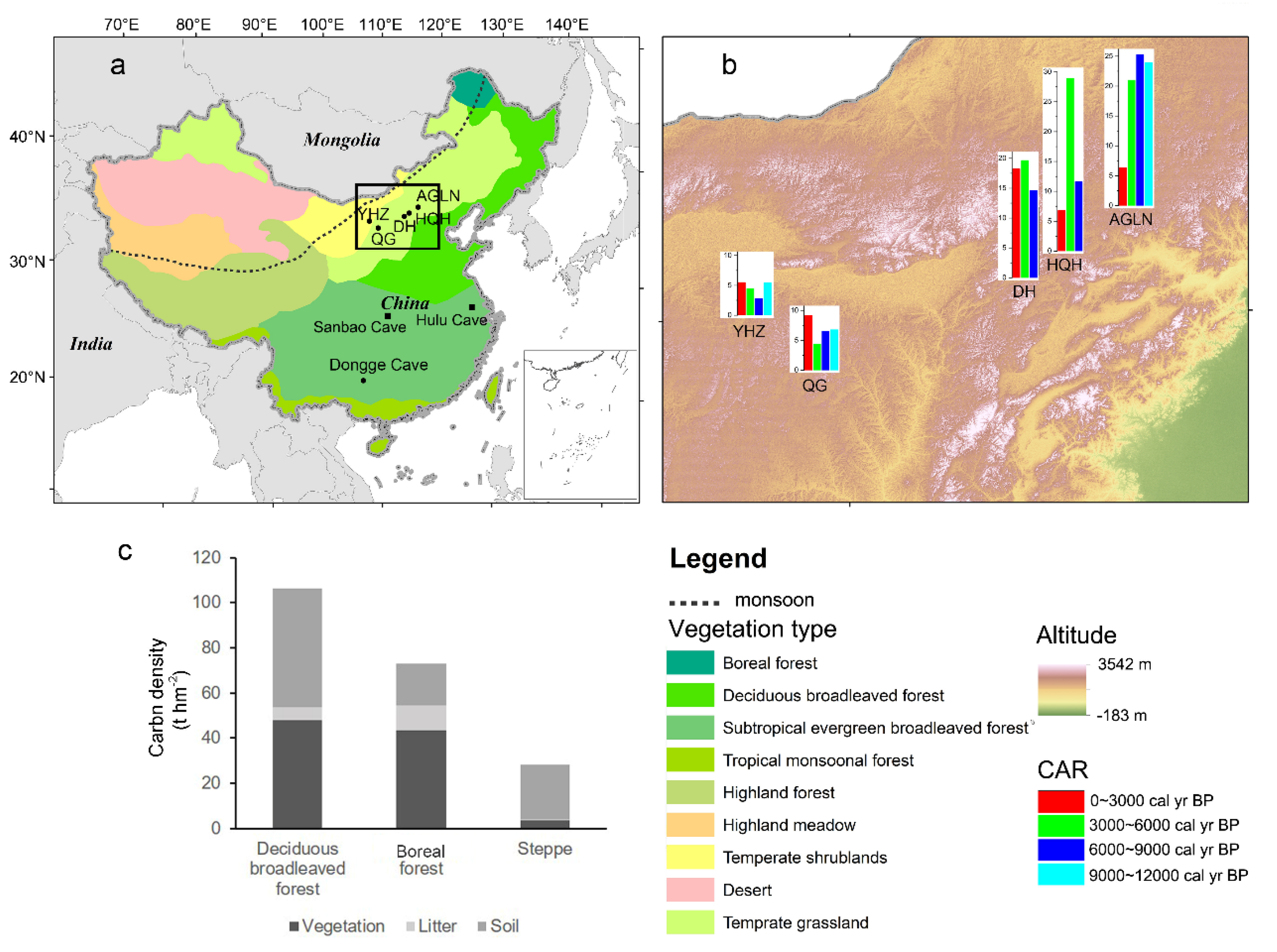
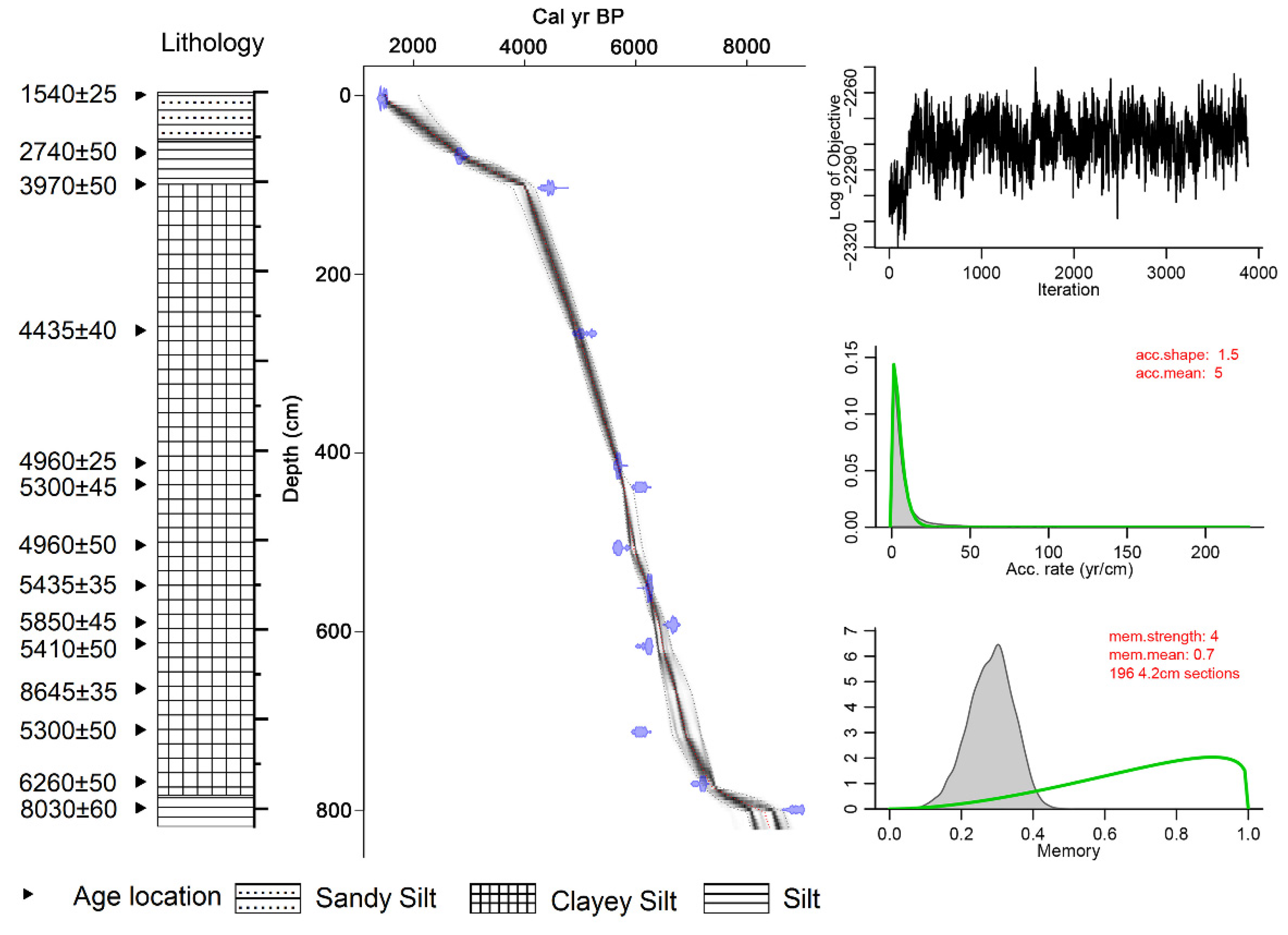
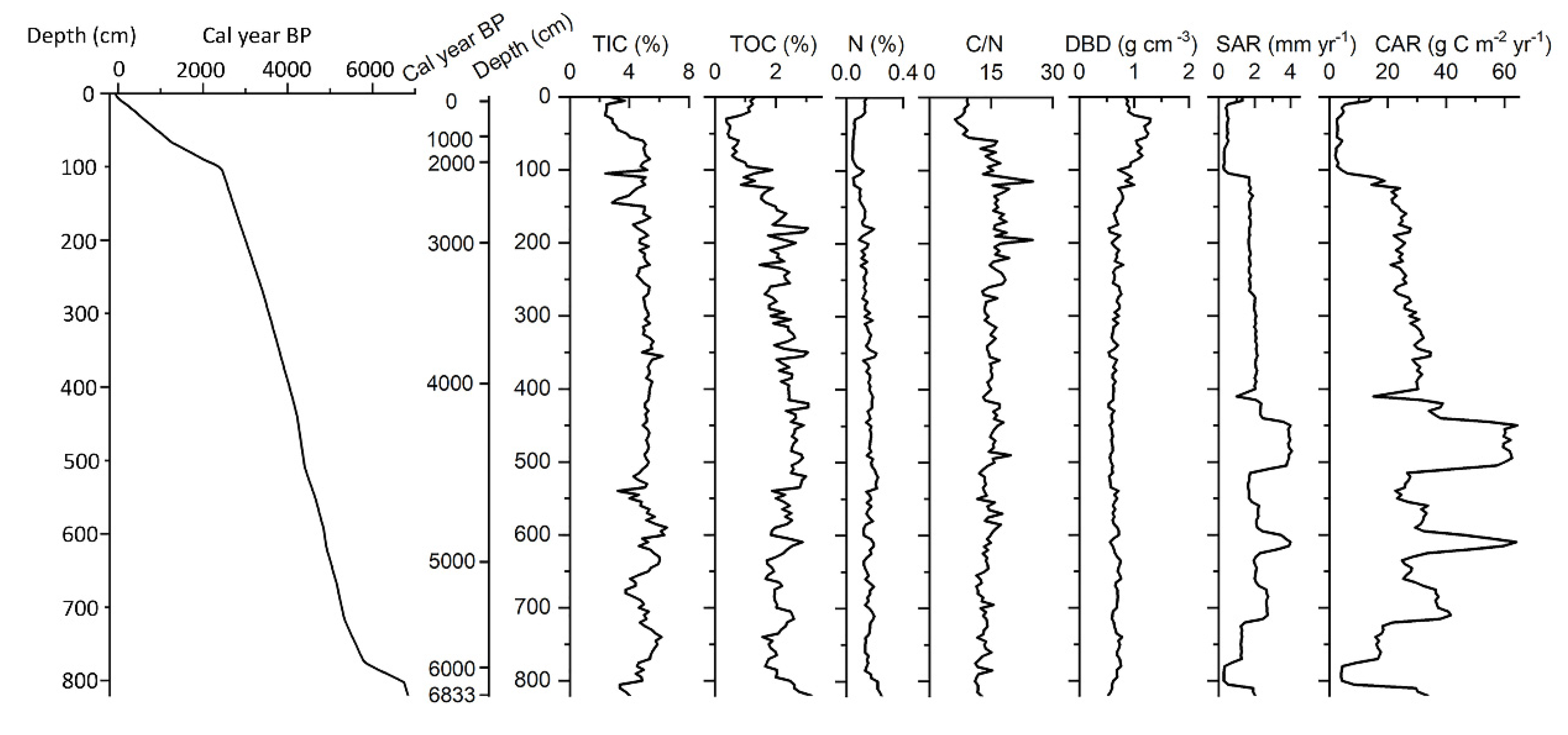
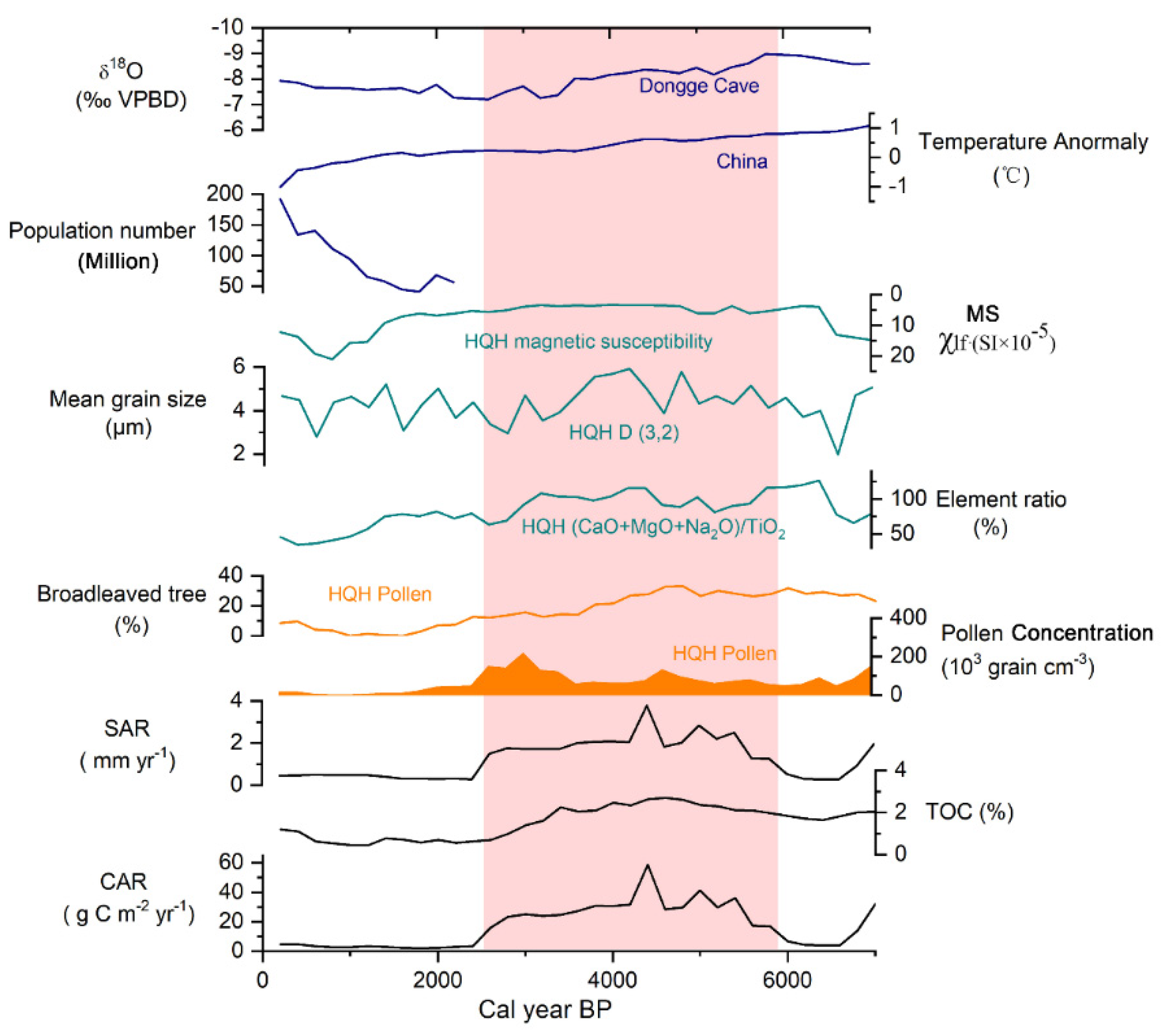

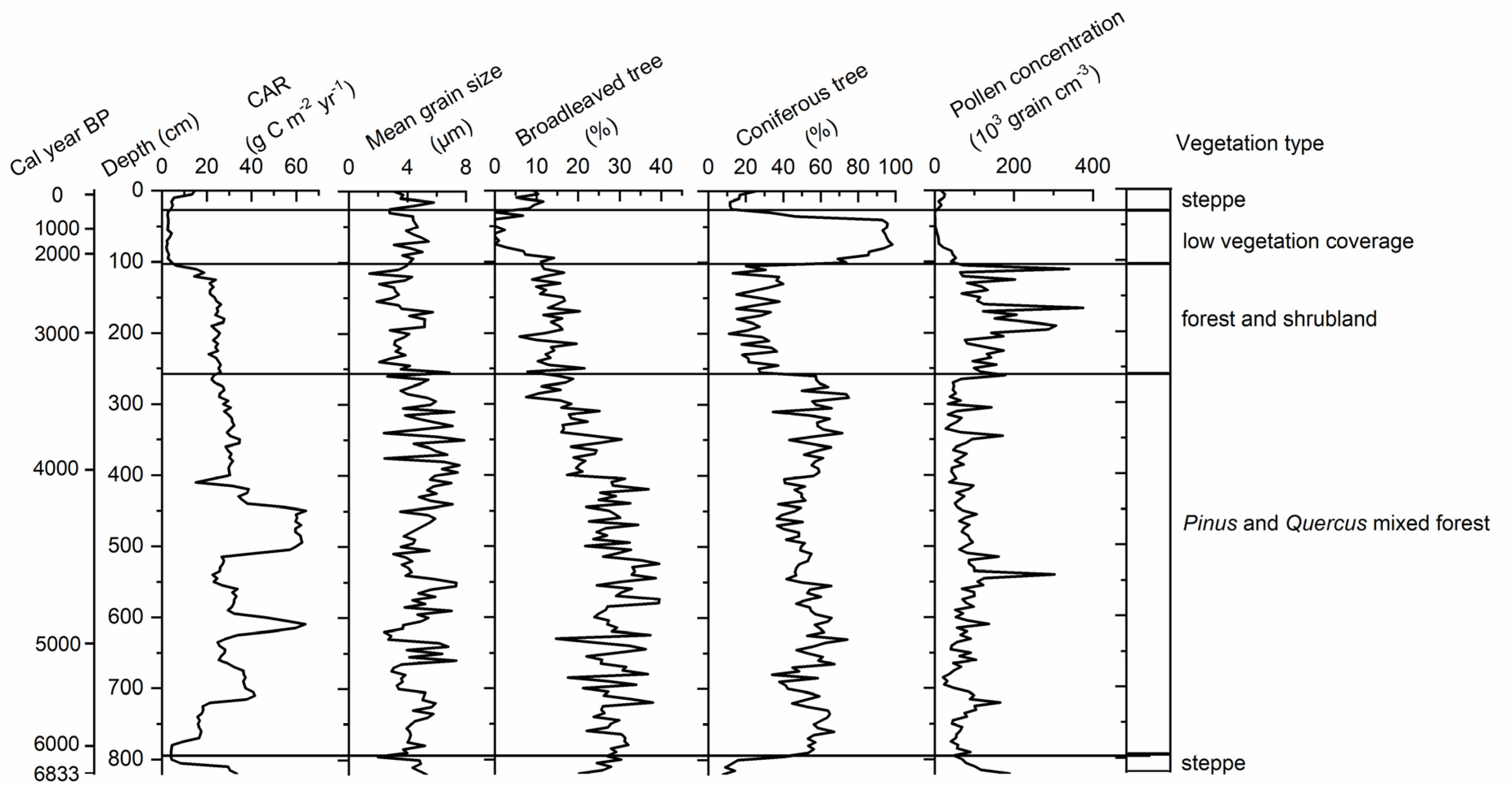
| Variables | Temperature | δ18O of Caves | Sand/Non-Sand | Mean Grain Size | Magnetic Susceptibility | Element Ratio | Na/Al | AP/NAP | Pollen Concentration | Broadleaved Tree Pollen Percentage |
|---|---|---|---|---|---|---|---|---|---|---|
| δ18O of caves | −0.67 ** | |||||||||
| Sand/non-sand | −0.72 ** | 0.16 | ||||||||
| Mean grain size | 0.10 | −0.22 | 0.07 | |||||||
| Magnetic susceptibility | −0.39 * | 0.07 | 0.50 ** | −0.23 | ||||||
| Element ratio | 0.66 ** | −0.45 ** | −0.58 ** | 0.27 | −0.80 ** | |||||
| Na/Al | 0.29 | −0.14 | −0.38 * | 0.28 | −0.78 ** | 0.82 ** | ||||
| AP/NAP | −0.16 | 0.25 | −0.07 | −0.09 | 0.07 | −0.12 | −0.13 | |||
| Pollen concentration | 0.44 ** | −0.03 | −0.38 * | −0.00 | −0.49 ** | 0.42 * | 0.44 * | −0.48 ** | ||
| Broadleaved tree pollen percentage | 0.79 ** | −0.78 ** | −0.38 * | 0.24 | −0.47 ** | 0.64 ** | 0.41 * | −0.51 ** | 0.46 ** | |
| Coniferous tree pollen percentage | −0.07 | 0.19 | −0.18 | 0.11 | −0.06 | 0.05 | 0.01 | 0.77 ** | −0.55 ** | −0.39 * |
| Variables | TOC | SAR | CAR | Reference |
|---|---|---|---|---|
| Temperature (China) | 0.69 ** | 0.40 * | 0.45 ** | [41] |
| Precipitation (δ18O of caves) | −0.54 ** | −0.21 | −0.27 | [37,38,39] |
| Sand/non-sand (Huangqihai) | −0.38 * | −0.3 | −0.31 | [20] |
| Mean grain size (Huangqihai) | 0.29 | 0.34 * | 0.37 * | This study |
| Magnetic susceptibility (Huangqihai) | −0.52 ** | −0.50 ** | −0.51 ** | Wang et al. unpublished |
| Element ratio (Huangqihai) | 0.65 ** | 0.50 ** | 0.54 ** | This study |
| Na/Al (Huangqihai) | 0.46 ** | 0.42 * | 0.44 ** | This study |
| AP/NAP (Huangqihai) | −0.56 ** | −0.40 * | −0.40 * | [20] |
| Pollen concentration (Huangqihai) | 0.69 ** | 0.52 ** | 0.54 ** | [20] |
| Broadleaved tree pollen percentage (Huangqihai) | 0.84 ** | 0.57 ** | 0.61 ** | [20] |
| Coniferous tree pollen percentage (Huangqihai) | −0.54 ** | −0.32 | −0.34 | [20] |
| Human activity (Population number) | 0.45 | 0.67 * | 0.79 ** | [42] |
Publisher’s Note: MDPI stays neutral with regard to jurisdictional claims in published maps and institutional affiliations. |
© 2021 by the authors. Licensee MDPI, Basel, Switzerland. This article is an open access article distributed under the terms and conditions of the Creative Commons Attribution (CC BY) license (https://creativecommons.org/licenses/by/4.0/).
Share and Cite
Hao, Q.; Yang, S.; Song, Z.; Wang, Z.; Yu, C.; Wang, H. Vegetation Determines Lake Sediment Carbon Accumulation during Holocene in the Forest–Steppe Ecotone in Northern China. Forests 2021, 12, 696. https://doi.org/10.3390/f12060696
Hao Q, Yang S, Song Z, Wang Z, Yu C, Wang H. Vegetation Determines Lake Sediment Carbon Accumulation during Holocene in the Forest–Steppe Ecotone in Northern China. Forests. 2021; 12(6):696. https://doi.org/10.3390/f12060696
Chicago/Turabian StyleHao, Qian, Shilei Yang, Zhaoliang Song, Zhengang Wang, Changxun Yu, and Hailong Wang. 2021. "Vegetation Determines Lake Sediment Carbon Accumulation during Holocene in the Forest–Steppe Ecotone in Northern China" Forests 12, no. 6: 696. https://doi.org/10.3390/f12060696
APA StyleHao, Q., Yang, S., Song, Z., Wang, Z., Yu, C., & Wang, H. (2021). Vegetation Determines Lake Sediment Carbon Accumulation during Holocene in the Forest–Steppe Ecotone in Northern China. Forests, 12(6), 696. https://doi.org/10.3390/f12060696






